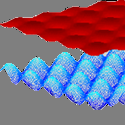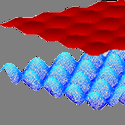Rotating condensates show new vortex behavior
Ultracold atoms trapped in optical lattices provide a controllable way to study phenomena found in condensed matter, such as Mott-insulator transitions and Anderson localization. By rotating quantum gases one can simulate what happens when a magnetic field is applied to such condensed matter analogs. Now, writing in Physical Review Letters, Ross Williams, Sarah Al-Assam, and Christopher Foot of Oxford University, UK, combine these two approaches to investigate the effects on an ultracold quantum gas placed in rotating optical lattice.
A rubidium- condensate was created with conventional cooling and trapping methods, while interference of four intersecting laser beams formed the optical lattice. Acousto-optical deflectors were used to rotate these laser beams, and hence the lattice, about a central axis. This rotation led to the formation of vortices, and the authors were able to track the number of vortices as a function of rotation frequency and depth of the lattice wells. Williams et al. found a new regime for vortex nucleation: when the lattice wells are deep, the novel behavior indicated that the vortices were formed locally at a lattice plaquette, created by rotation-induced phase differences between condensates localized at different lattice sites. – David Voss





